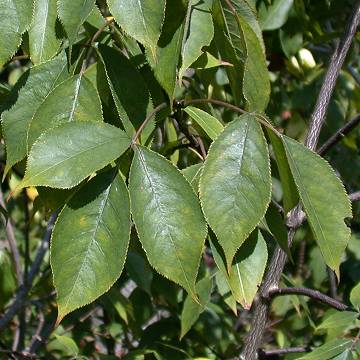

Staphylea trifolia - (image 1 of 8)
Taxonomy
Family: Staphyleaceae
Habitat
Wooded slopes, wooded floodplains.
Associates
On mesic wooded slopes with Actaea pachypoda, Adiantum pedatum, Allium tricoccum, Carya cordiformis, Caulophyllum thalictroides, Dentaria laciniata, Dicentra cucullaria, Geranium maculatum, Hepatica acutiloba, Hydrophyllum virginianum, Isopyrum biternatum, Lithospermum latifolium, Phlox divaricata, Quercus rubra, Sanguinaria canadensis, Tilia americana, Trillium recurvatum. On wooded floodplains with Asarum canadense, Celtis occidentalis, Fraxinus americana, Menispermum canadense, Polymnia canadensis, Ulmus americana. Also with Acer saccharum, Asimina triloba, Cercis canadensis, Fagus grandifolia, Lindera benzoin, Polygonatum pubescens, Sassafras albidum.
Distribution
Quebec to Ontario and MN, south to GA and MO.
Morphology
Woody shrub to 15' and almost as wide. Leaves opposite, trifoliate; leaflets oblong to elliptic or ovate, to 4" long, acuminate, finely serrate, dark green above and pubescent beneath, the terminal leaflet with a slightly longer petiolule than the side leaflets. Stems smooth, green to brown; older bark green-gray with vertical white stripes. Flowers perfect, greenish-white, bell shaped, to 1/3" long, in nodding, 1.5-2" long panicles. Fruit a 3-lobed, 1.5" long inflated capsule, papery, pale green changing to light brown. Seeds round, hard, shiny, yellow-brown, 1/4" diameter.
Notes
Flowers mid April to early June
Wetland indicator: Facultative
Although this shrub lacks a single spectacular aspect, the leaves, flowers, and striped bark are all interesting attributes. The fall color is sometimes a good yellow and on open sites both the leaves and fruit can change to a variety of brilliant oranges and reds.
References
Dirr, Michael A. 1998. Manual of Woody Landscape Plants: Their Identification, Ornamental Characteristics, Culture, Propagation and Uses.
5th ed. Champaign, Illinois: Stipes Publishing L.L.C.
Gleason, Henry A. and A. Cronquist. 1991. Manual of Vascular Plants of
Northeastern United States
and Adjacent Canada. Second Ed.
The New York Botanical Garden. Bronx, NY
Swink, F. and G. Wilhelm. 1994. Plants of the Chicago Region.
Indiana Academy of Science. The Morton Arboretum. Lisle, Illinois.
|
Michael Hough © 2005 |